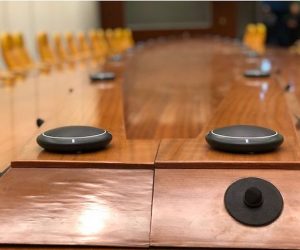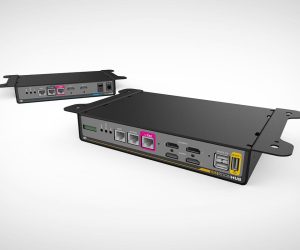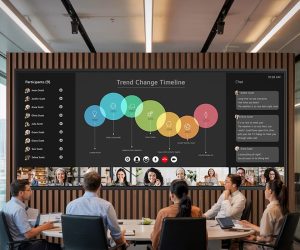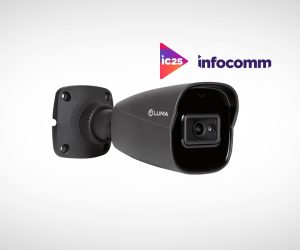
Boardroom Acoustics
Boardrooms are all about effective communication, which makes the acoustics top priority.
Text / Andrew Steel
Apart from Friday afternoon beers and the odd celebration, boardrooms are generally used for important meetings where people need to communicate with a minimum of distraction. For this to work — whether it’s a meeting within the room, a teleconference or a video conference — speech needs to be clear and easily understood. It may seem painfully obvious that the object of talking to someone is for them to hear you, and hopefully understand you, but this simple and critical relationship is often defeated by the bad acoustics of the room. In fact, it doesn’t really matter if it’s a boardroom, meeting room, conference room or an office being used for a meeting, bad acoustics can make or break the entire meeting.
In addition to proper communication, there’s also the issue of privacy. If you can hear the people outside it’s not only distracting, but means there’s a fair chance they can hear you too.
The interesting thing about this topic is that a very small number of boardrooms actually have good acoustics. The obvious question that arises is, if they are all so bad, why doesn’t anyone try to fix them? The short answer is: most people don’t know how. There’s a widespread misunderstanding of acoustics that leads to no solutions, poor solutions or more commonly the wrong solutions.
Take for example the desktop microphone used for audio or video conferencing. It has evolved to be quite a sophisticated piece of equipment with all sorts of equalisation and echo cancellation capabilities. Despite this, I have seen them replaced multiple times, moved around the boardroom table and sat on foam to try and get decent quality audio to the participants in other locations. Rarely is the microphone at fault. There are two common problems: a room with lots of reverberation and a very long boardroom table. The solutions are of course, to reduce the reverberation and use a number of microphones along the table. This is just one example though, and we will look at each issue in more detail.
BAD VIBES — TOO MUCH REVERB
Too much reverberation is probably the biggest cause of bad boardroom acoustics, so it’s a good place to start. Simply fixing this will make a huge and very noticeable difference. The reason for the high reverberation is the prevalence of glass, painted plasterboard walls and high-gloss glass or stone table tops. All of these surfaces reflect sound very well so it just bounces around the room causing all sorts of interference — termed ‘reduced speech intelligibility’. A carpeted floor is usually the only surface that absorbs sound but it can cause problems of its own. Unless it’s ankle-high shagpile, carpet absorbs high frequency sound only. This leaves the middle and lower frequencies bouncing around and is responsible for that heavy or chesty sound in people’s speech which is very hard to deal with. It is the most common description when people say they are having trouble being heard.
The fix is to get some absorption in the room that does for middle and lower frequencies what carpet does for high frequencies. A simple choice is heavy drapes that can be drawn when needed. If the view is more important than that, very fine translucent mesh blinds can be used. In either case they must be hung at least 100mm from the glass to have an effect.
Acoustic ceiling tiles can also be used, but only if the walls of the room extend to the slab above (ie. such that there isn’t a shared ceiling cavity). Acoustic ceiling tiles do their work as sound passes through them, but the sound that passes through can compromise privacy (discussed later in this article).
The most effective countermeasure against excessive reverberation is purpose-made acoustic panels. They have high acoustic absorption and can be made in colours to suit the décor. They can even have pictures like the corporate logo or dogs playing poker printed on them. One panel won’t fix a room though, so you need to anticipate covering up to 40% of the flat wall surfaces that are above the level of the table top.
MULTIPLE MICROPHONES
Once the room is acoustically treated, many problems will evaporate for both local speech and speech using microphones. Saying that, don’t expect a microphone that functions well in a small meeting table to thrive on a long boardroom table. Long tables will have some people closer to the microphone than others, so the level of each person’s speech when it reaches the microphone can vary quite a lot. Some have automatic gain control but they will still struggle with large differences in level. The way to overcome this problem is to use a number of microphones along the table. They can be microphones mounted flush into the table, fixed on goosenecks or on retractable goosenecks. One interesting tip (may seem trivial, but can make a big difference), is to let people know the microphones are coupled to the desk, so tapping their pen or scraping bangles is not a good idea.
Boxy rooms with reflective walls, low ceilings and acres of hard table top surfaces make for a hostile acoustic environment for high-intelligibility conferencing.
PRESENTING A PROBLEM
If your microphones are positioned and distributed properly in a room with good acoustics, meetings should be relatively free from acoustical problems. The last hiccup, though, can come when presentations are made. Whether it’s someone addressing the room with amplified sound, or conducting a presentation over a video link, there are a few things that can, and often do, cause headaches.
Lapel microphones are our first problem. They fail often enough to warrant some advice: pack a second system. Actually, while you’re at it, it’s a good idea is to use two lapel microphones — one for the video link and one for the local sound (if there is local amplified sound). In a worst case scenario, if one failed, the other one could be used (with a quick mixer reassignment) for both. Two microphones also provide better control, because the level of sound sent to remote sites is independent of the local sound. This can be useful in preventing feedback issues…
FEEDBACK
Feedback or echo is the last problem on the list. In an acoustically-treated room we have just described, loaded with appropriate microphones, feedback is unlikely, but it can still happen. It happens when the incoming audio from a remote site is routed back to the send by a wrong mixer assignment. As with so many similar things, a simple plan, routing diagram and checklist to cover the details described so far will go a very long way towards a successful meeting. After all, the effort spent in setting up properly with a dry run, is a small price to pay compared to the disasters that can occur when plugging and unplugging in a panic during a conference — doesn’t even bear thinking about it.
THE WALLS HAVE EARS
All we have to do now, to attain boardroom bliss, is to ensure meetings are kept private. Boardrooms are known for being the flash, fancy or even luxurious rooms, but the big spending seems to stop at the décor. More often than not, the walls in office buildings only go as high as the ceiling and they are quite thin and uninsulated. This may save huge amounts of money in a whole building, but it makes it very hard to keep rooms acoustically isolated from each other. With penetrations in the ceiling for lights, air conditioning etc, sound just travels into the ceiling cavity and straight back down to the next rooms, and visa-versa. As well as this, the air conditioning ducts usually feed multiple rooms and act as an acoustical connection between them. Building the walls back up to meet the slab above, and re-ducting the air conditioning are rarely options within the budget. The usual approach is to fill the gap between the walls and the slab above by hanging mass-loaded vinyl or stacking insulation, about 600mm wide, into the gap. This works reasonably well and considering the expense and effort needed to rebuild walls and air conditioning ducts, is a good compromise.
If the walls themselves are not soundproof enough, adding a layer of plasterboard and a product like Green Glue is the best option. Opening the wall to put insulation inside is, of course, more difficult than most would want to tackle. The remaining breaches of acoustic privacy are the electrical outlets, switches etc. Power points and the like get installed “back to back” on a wall and cable ducts often split across rooms. These penetrations and ones like them are more than enough for sound to travel through. Fortunately, it’s just a matter of blocking the free spaces with expanding foam or sealing them with a mastic sealant. Good door seals on any doors will maintain the overall level of soundproofing and make for a room with adequate privacy.
So, as I said at the start, having a boardroom with good acoustics isn’t all that difficult. It requires a little attention to detail and some forethought. There are methods to achieve the necessary acoustic conditions, set up microphones and ensure privacy, none of which are too difficult, and all of which make great improvements. The only oddity is why these things get neglected so often.














RESPONSES